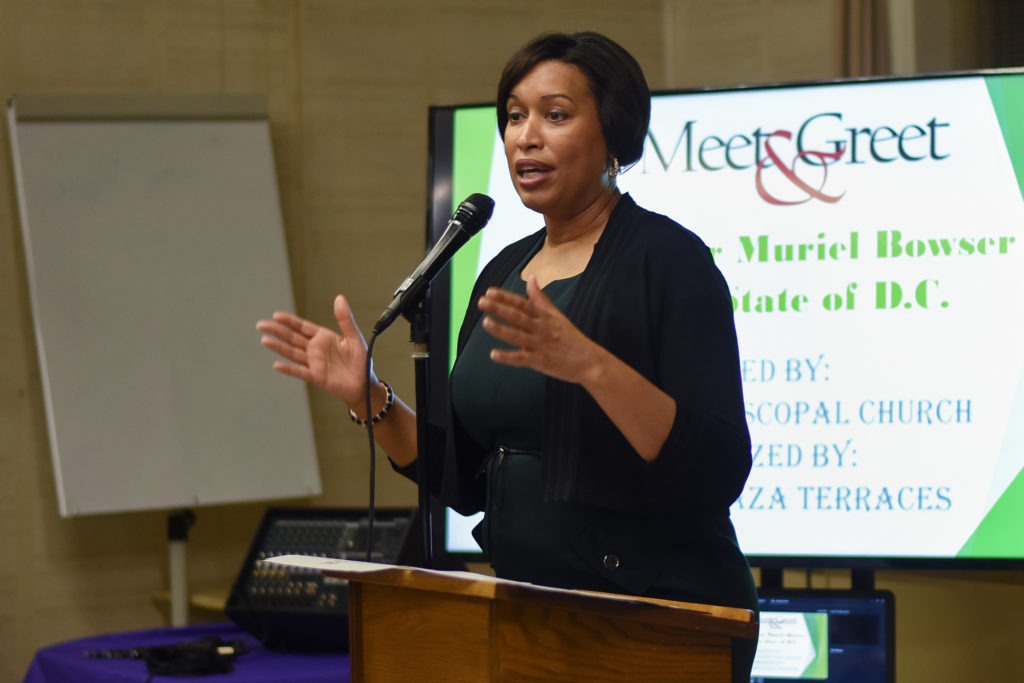Updated: Nov. 27, 2018 at 12:39 p.m.
District officials spoke to about 50 Foggy Bottom residents about a range of issues plaguing D.C. in an address on campus Monday evening.
Mayor Muriel Bowser and District officials from sectors like the D.C. Department of Health fielded residents’ concerns about transportation, homelessness and rats for about two hours at St. Mary’s Episcopal Church. Bowser said the District is improving in many aspects, like population and economic growth, but there is still work to be done in areas like social programs.
“We should all be proud of how our city and economy are driving,” she said. “In some ways, we have never been doing better as a city.”
In case you missed it, here are the biggest topics authorities discussed at the town hall:
Increasing transportation funding
Bowser thanked taxpayers for their help in transforming transportation in the District, citing a recent deal between D.C., Virginia and Maryland to provide $500 million a year to assist ongoing maintenance efforts for the Metro.
Bowser said she hopes to replicate the District’s AlleyPalooza initiative – a project that aims to renovate eight alleys in all eight wards over a 12-week period – on local roads. The District Department of Transportation has repaired more than 400 alleys since the program started in 2015.
“We will continue to ask the [D.C.] Council to consistently fund our local roads program, which will get us in this financial plan, in the next five years, to a state of good repair on all local roads,” she said.
Addressing homelessness
Bowser said she recognizes the “great concern” about the number of people experiencing homelessness in Foggy Bottom and discussed how the city plans to address the issue.
Bowser also addressed criticism she faced for closing D.C. General, the District’s largest homeless shelter, last month. Advocates voiced concerns that many homeless families were displaced after the shelter closed and did not immediately have another shelter to go to.
But Bowser said family homelessness has decreased by 40 percent and individual homelessness has decreased by 17 percent since 2016.
“Our focus has been on how we fix the whole system from prevention, to entry, to getting in and getting services, to getting to affordable housing,” she added.
Residents raised concerns that homeless encampments appear to be increasing in size. Bowser said the District implements the “right to shelter” during periods of cold weather for those experiencing homelessness, but the District cannot force people into shelters because homelessness is not illegal.
But officials also said that moving people to shelters doesn’t fix all problems facing the homeless community, adding that many experiencing homelessness also struggle with mental health issues.
Jay Melder, the chief of staff for the Office of the Deputy Mayor for Health and Human Services, distributed cards that included information about mental health services to give to those experiencing homelessness.
“Mental health is important for everyone, and it is especially important for people who are going through the crisis of homelessness,” he said.
Removing rats
Many residents in attendance posed concerns about the presence of rats in Foggy Bottom. Bowser said she has hired employees at the health department to work on the problem and will look into improving the 311 system, which allows residents to directly connect with city services to report rat problems.
Gerard Brown, the program manager for the D.C. Department of Health’s rodent control division, said the department will launch a pilot program in December to deploy containers of non-toxic, sweet liquid in areas rats frequent. The rats are attracted to the liquid, and if they drink it, they will become sterile, Brown said.
“It’s not going to work in every place,” Brown said. “But in places where it has been a problem for a very long time, we will use it.”
This post was updated to reflect the following correction:
A previous version of this post misattributed a quote from Jay Melder. The quote is now correctly attributed. We regret this error.




